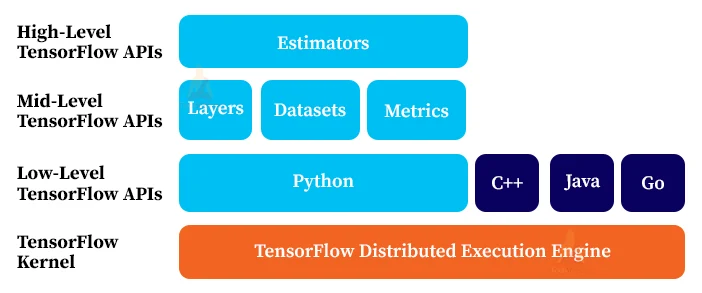TensorFlow APIs
TensorFlow is identical to a python package and a lot of elements are similar to that of Python. But the central essence of TensorFlow is – distributed runtime. This functionality is executed in multiple languages and one of them is Python. In this article, we will learn about tensorflow APIs. Let’s start!!!
TensorFlow API – TensorFlow Runtime Engine
The runtime of TensorFlow is composed in C++ language but the frontend as you can notice can be executed by utilizing different languages like C, C++, R, Java, etc. The benefit of these APIs in TensorFlow is described below.
1. C API for TensorFlow
The sole APIs containing the authorized support of TensorFlow are C and Python API (some parts). C APIs should be utilized whenever you are about to create TensorFlow API for some other languages as plenty of languages have methods to link with C language.
2. C++ API for TensorFlow
The runtime of TensorFlow is composed in C++ and mostly C++ is related to TensorFlow via header files in tensorflow/cc. C++ API yet is in the experimental phases of growth but Google dedicates to work with C++.
3. Python API for TensorFlow
Python is the considerable recognizable and “the primary” language when it comes to TensorFlow and its expansion. It was one of the foremost languages backed by TensorFlow and still sustains most of the elements. It seems as though TensorFlow’s functionality determines in Python and then transferred to C++.
The Python API is so miscellaneous that you will have to decide which level of API in TensorFlow, you want to operate on.
4. R API for TensorFlow
The R API for TensorFlow created by RStudio has a distinguishable method from the standard method for delivering API support. R API completely includes the Python API which is separate from what TensorFlow varies with its APIs. But the users of R have all the keys to elements of Python API.
Additionally, one can see there are different APIs known for Java, Go, Rust, Haskel, and some of the different unofficial ones beyond the TensorFlow project- C# and Julia.
APIs Inside TensorFlow Project

The APIs inside TensorFlow are always Python-based and they include low-level options for its users such as tf.manual or tf.nnrelu which are employed to make neural network architecture. These APIs are also utilized to aid in creating deep neural networks including increased levels of conception.
Utilizing the Estimators API, you can establish an interface and can deliver actions to perform into the Estimator system. Canned estimators—pre-defined models are present there which keep the estimator conventions
e.g., LinearRegressor or DNNClassifier.
The functionality known via this group is as follows –
- automatic checkpoints
- automatic logging
- separate training/evaluation/prediction
- simplified training distribution
TensorFlow offers a refined multi-thread, multi-queue, and queue-runner design that utilize for loading data. The developers of TensorFlow produced the Dataset API to manage this problem and deliver a candy interface as a bonus.
APIs outside TensorFlow Project
Some other TensorFlow APIs originated beyond of TensorFlow project by machine learning devotees. Let’s see some TensorFlow API beyond TensorFlow Project:
1. TFLearn: This API shouldn’t be considered as TF Learn, which is TensorFlow’s tf.contrib.learn. It is a different Python package.
2. TensorLayer: It comes as a different package and is different from what TensorFlow’s layers API has in its pack.
3. Pretty Tensor: It is a Google project which shows an eloquent interface with chaining.
4. Sonnet: It is a project of Google’s DeepMind that provides a modular approach.
Conclusion
In this article, we noticed what TensorFlow APIs are and how they operate. Moreover, we got to learn about the TensorFlow API for additional languages. In expansion, we also learned how TensorFlow is separate from Python and how it got its uniqueness in machine learning and deep neural network areas.
